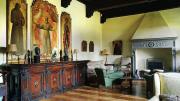Scholars at Villa I Tatti, the Harvard Center for Italian Renaissance Studies on the outskirts of Florence, Italy, gather for after-lunch coffee in the salone (below). There they are overseen by, from left, The Blessed Ranieri, Saint Francis in Glory, and Saint John the Baptist, on three panels painted in the fifteenth century by the Sienese Stefano di Giovanni, known as Sassetta.
Bernard Berenson, A.B. 1887, and his wife, Mary, found the panels in 1900 in a Florence antique shop—a tiny “out-of-the-way hole-and-corner sort of place,” said Mary—just as they were furnishing their newly acquired home, I Tatti.
Bernard Berenson, who became famous as a connoisseur of the “Old Masters” and an arbiter of taste, died 50 years ago at 94. He gave I Tatti to Harvard, along with its gardens, olive groves, and vineyards, his library of 50,000 books (now much enlarged), his photographs (now numbering 300,000), and about 140 works of Italian Renaissance art. The villa opened as a study center in 1961. Today, 15 fellows come for a full year and 20 more for shorter periods. One recent fellow was Machtelt Israëls, an art historian from the University of Amsterdam. She cast a speculative eye on these Sassetta panels.
“They are the masterpiece of the collection,” says I Tatti’s director, Professor Joseph Connors. The Berensons prized their panels but didn’t know that they were originally part of a far larger whole: an altarpiece standing 16 feet high and 20 feet wide that was decorated, front and back, between 1437 and 1444 with 60 paintings for a Franciscan church in the small Tuscan town of Borgo San Sepolcro. In a crypt below the altar lay the remains of the Blessed Ranieri, whose miracles Sassetta recounted with his brush among a profusion of other images.
The dismantling of this masterpiece for liturgical reasons occurred between 1578 and 1583. Today only 27 of its paintings are known to exist, in 12 museums. But Israëls conceived the notion that the altarpiece could be reconstructed in a different medium because Sassetta’s patrons had given him a scripta, detailed instructions, a document discovered in 1991. Israëls assembled a team of 30 experts—in art and general history, painting technique and conservation, woodworking, architecture, and liturgy, including all scholars studying the artist—from eight countries. They have now produced Sassetta: The Borgo San Sepolcro Altarpiece, a richly illustrated book edited by Israëls, just published by I Tatti, and distributed by Harvard University Press. Thanks to this remarkable collaboration, what Dutch art historian Henk van Os has called the Rolls-Royce of early Italian Renaissance altarpieces is virtually together again—and gleams.









